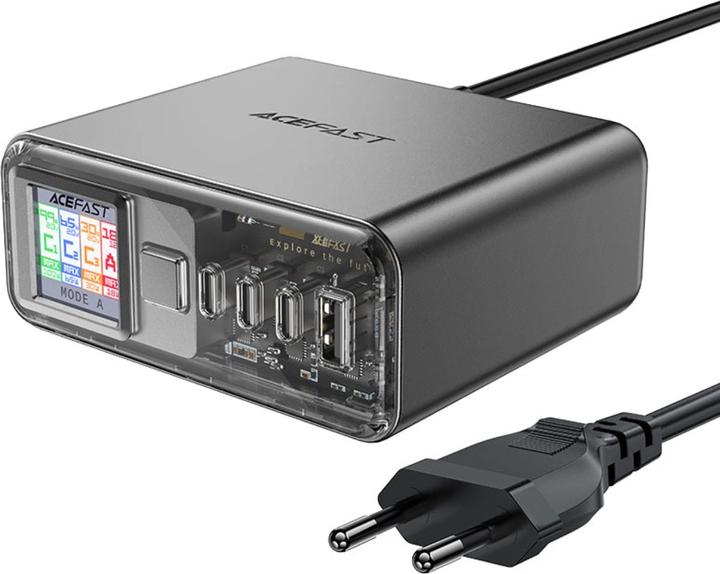

Acefast Z4 review: powerful desk charger
Tech nerds are loving transparent chargers these days. I didn’t become a fan after testing the Acefast Z4, but the charger itself is good.
Nearly every device I own could be charged with my test device: MacBook, iPad, iPhone, power bank and mini vacuum cleaner. Four ports, three USB-C, one with USB-A – plenty of inviting connectivity options on this desktop power charger.
After all, the thing has quite a prominent spot on my desk during my review. It draws power from the multiple socket, making it available to the power-hungry gadgets. Maximum power output: 218 watts.
Mind you, this is more of a theoretical value. On the one hand, the device itself uses some power, albeit only just under one watt (an excellent value!). The 217 watts left are distributed across the four slots. This doesn’t happen automatically, but I can control the process by pressing a button on the front of the device. There are four different modes, all visible on a diagram in a small printed manual.

Source: Martin Jungfer
And there are two more problems in this respect. Firstly, the display is quite small: three centimetres or 1.2 inches. Aww, look at the little thing. I have to get very close to even tell which mode I just selected. Secondly, I either need to know by heart which mode brings maximum performance to which port, or I have to try and decipher the even smaller numbers on the display. The names for the ports, which always stay the same, are the most prominent. In contrast, other details that change and would be more important are much smaller.
Charger hardly heats up
In practice, however, this doesn’t matter in most cases anyway. I’ve set the device up so that the first USB-C port on the left spits out a maximum of 100 watts. This makes it the designated slot for my MacBook’s charging cable, which draws the most power. For other devices, the possible 65 and 30 watts are easily sufficient. Fast Charge and Power Delivery are supported by Acefast. Gallium nitride (GaN) is used inside the Z4, allowing good energy conversion without the device becoming even lukewarm during use.
I hardly ever use the one USB-A port, although it’d still be usable with 18 watts. By now, however, I simply don’t have cables that still use the old-fashioned plug.
The Acefast Z4 delivers what it promises in terms of power output. On top of that, the display also shows how many volts are being drawn and how many watts are being output. A small device, which I use for testing, confirms the values.

Source: Martin Jungfer
Electronics behind Plexiglas
That’s all for the practical bit. Now on to aesthetics. The housing measures 9 by 10 centimetres and is 4 centimetres in height, all in a dark grey plastic. Mind you, the whole outer bit also magically attracts fingerprints. In the first five minutes, I also find looking through the Plexiglas quite interesting. Behind it lie some electronic components atop the circuit board. (If you’re interested in semitransparent chargers, you can read a review of a similar device by fellow editor Lorenz Keller here).
Everything Acefast does looks very clean and high-quality. But they won’t score too many brownie points with nerds here – you just can’t see enough of the insides. This Shargeek power bank, for example, is in a completely different league.

The slots are located on the front right of the housing, ensuring that all cables snake from there to their target devices. As someone who really dislikes cable clutter, that’s a plus. I can turn a certain area of my desk into a charging zone, bundle the cables and lead them all to the same spot.

Source: Martin Jungfer
In a nutshell
Plenty of power at a decent price
Pro
- Very low self-consumption (<1 Watt)
- Well-manufactured
- High power output
Contra
- Susceptible to fingerprints
- Display not ideally used
Journalist since 1997. Stopovers in Franconia (or the Franken region), Lake Constance, Obwalden, Nidwalden and Zurich. Father since 2014. Expert in editorial organisation and motivation. Focus on sustainability, home office tools, beautiful things for the home, creative toys and sports equipment.



